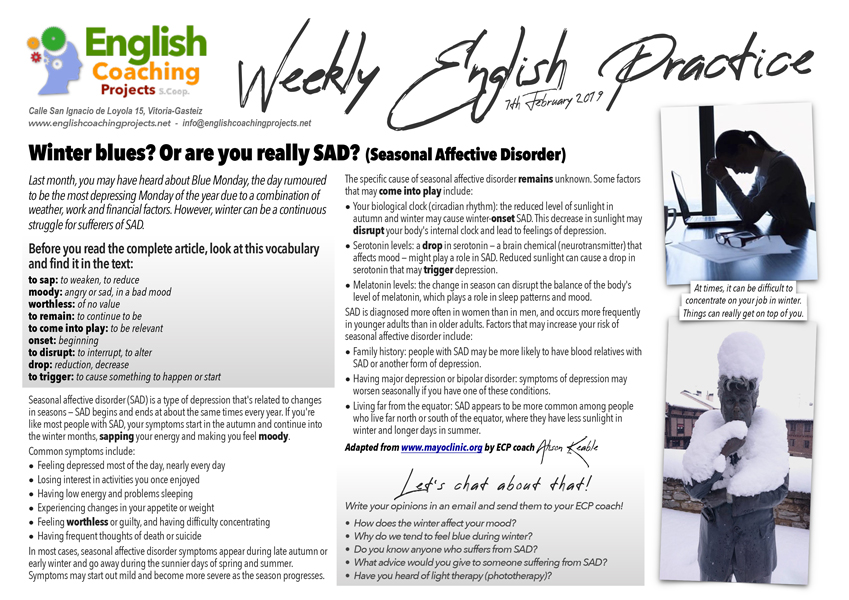In this week’s Weekly English Practice, ECP coach Alison introduces the topic of Seasonal Affective Disorder (SAD), which is a common problem at this time of year.
Click on the image to download the pdf
Last month, you may have heard about Blue Monday, the day rumoured to be the most depressing Monday of the year due to a combination of weather, work and financial factors. However, winter can be a continuous struggle for sufferers of SAD.
Before you read the complete article, look at this vocabularyand find it in the text:
to sap: to weaken, to reduce
moody: angry or sad, in a bad mood
worthless: of no value
to remain: to continue to be
to come into play: to be relevant
onset: beginning
to disrupt: to interrupt, to alter
drop: reduction, decrease
to trigger: to cause something to happen or start
Listen to the audio (refresh the page if it’s not visible)
Seasonal affective disorder (SAD) is a type of depression that’s related to changes in seasons — SAD begins and ends at about the same times every year. If you’re like most people with SAD, your symptoms start in the autumn and continue into the winter months, sapping your energy and making you feel moody.
Common symptoms include:
- Feeling depressed most of the day, nearly every day
- Losing interest in activities you once enjoyed
- Having low energy and problems sleeping
- Experiencing changes in your appetite or weight
- Feeling worthless or guilty, and having difficulty concentrating
- Having frequent thoughts of death or suicide
In most cases, seasonal affective disorder symptoms appear during late autumn or early winter and go away during the sunnier days of spring and summer. Symptoms may start out mild and become more severe as the season progresses.
The specific cause of seasonal affective disorder remains unknown. Some factors that may come into play include:
- Your biological clock (circadian rhythm): the reduced level of sunlight in autumn and winter may cause winter-onset SAD. This decrease in sunlight may disrupt your body’s internal clock and lead to feelings of depression.
- Serotonin levels: a drop in serotonin — a brain chemical (neurotransmitter) that affects mood — might play a role in SAD. Reduced sunlight can cause a drop in serotonin that may trigger depression.
- Melatonin levels: the change in season can disrupt the balance of the body’s level of melatonin, which plays a role in sleep patterns and mood.
SAD is diagnosed more often in women than in men, and occurs more frequently in younger adults than in older adults. Factors that may increase your risk of seasonal affective disorder include:
- Family history: people with SAD may be more likely to have blood relatives with SAD or another form of depression.
- Having major depression or bipolar disorder: symptoms of depression may worsen seasonally if you have one of these conditions.
- Living far from the equator: SAD appears to be more common among people who live far north or south of the equator, where they have less sunlight in winter and longer days in summer.
Adapted from www.mayoclinic.org by ECP coach Alison Keable
Let’s chat about that!
Write your opinions in an email and send them to your ECP coach!
- How does the winter affect your mood?
- Why do we tend to feel blue during winter?
- Do you know anyone who suffers from SAD?
- What advice would you give to someone suffering from SAD?
- Have you heard of light therapy (phototherapy)?


